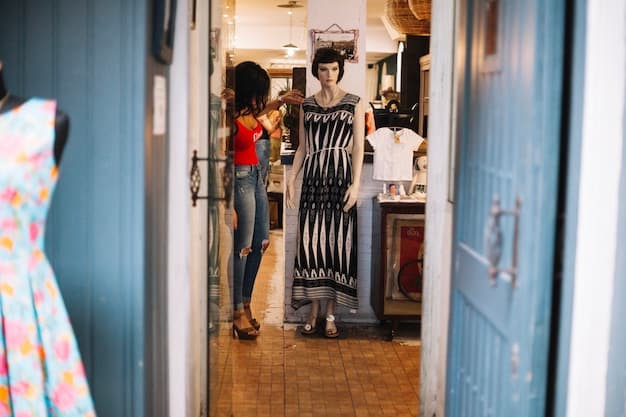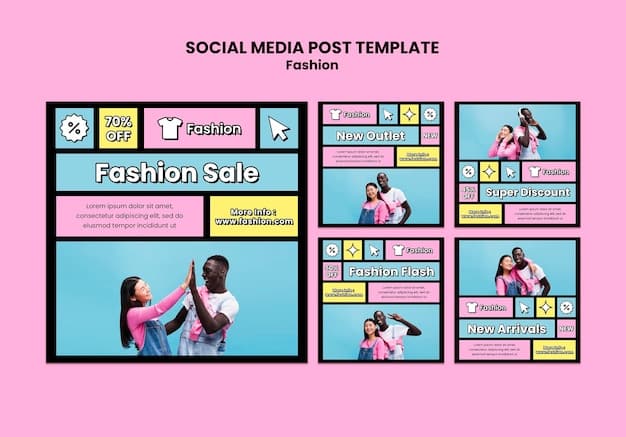Unlocking Success: Designer-Retailer Partnerships in the US

The Secret to a Successful Designer-Retailer Partnership: A US Case Study involves aligning brand values, fostering open communication, and implementing targeted marketing strategies to cater to the US market, ultimately driving mutual growth and enhanced customer engagement.
Navigating the world of fashion and design requires a keen understanding of collaboration, especially when it comes to designer-retailer partnerships. In the United States, where consumer preferences are diverse and the market is competitive, understanding the secret to a successful designer-retailer partnership: A US case study is crucial for sustained growth and mutual benefit.
Understanding the US Retail Landscape
The US retail landscape is vast and varied, presenting both opportunities and challenges for designers looking to partner with retailers. From high-end department stores to niche boutiques, understanding the market dynamics is the first step towards forging a successful partnership.
Key Characteristics of the US Retail Market
The US retail market is characterized by its diversity, innovation, and a strong emphasis on customer experience. Retailers are constantly evolving to meet changing consumer demands and preferences.
- Consumer Diversity: The US has a highly diverse population, with varying tastes, preferences, and buying behaviors.
- Technological Innovation: E-commerce and digital marketing play a significant role in the US retail market.
- Experiential Retail: Consumers seek unique and engaging shopping experiences.
Navigating this landscape requires designers and retailers to collaborate closely, leveraging each other’s strengths to create a compelling offering for the US consumer.

Building a Strong Foundation: Shared Values and Vision
A successful designer-retailer partnership begins with a strong foundation built on shared values and a common vision. Both parties must be aligned on their brand identity, target audience, and goals for the partnership.
Aligning Brand Identities
Brand alignment is essential for a cohesive and successful partnership. When a designer’s aesthetic complements a retailer’s brand image, it resonates better with consumers.
For example, a minimalist designer specializing in sustainable fashion might find a natural fit with a retailer known for its eco-conscious values and curated selection of ethical brands.
Defining Partnership Goals
Before entering into a partnership, designers and retailers should clearly define their goals. What do they hope to achieve through the collaboration, and how will they measure success?
Setting specific, measurable, achievable, relevant, and time-bound (SMART) goals can help keep the partnership on track and ensure that both parties are working towards the same objectives.
By establishing a solid foundation of shared values and a clear vision, designers and retailers can set themselves up for long-term success in the competitive US market.
Communication is Key: Fostering Open Dialogue
Open and honest communication is the cornerstone of any successful partnership. Designers and retailers must establish clear channels of communication and encourage regular dialogue to address challenges and seize opportunities.
Regular Check-ins and Feedback Sessions
Scheduled check-ins and feedback sessions provide a platform for designers and retailers to discuss progress, address concerns, and make adjustments as needed.
These meetings should be structured, with clear agendas and action items, to ensure that they are productive and effective.
Transparent Information Sharing
Transparency is essential for building trust and fostering a collaborative environment. Designers and retailers should be open about sharing relevant information, such as sales data, customer feedback, and market trends.
- Sales Data: Sharing sales data helps designers understand which products are performing well and which need adjustments.
- Customer Feedback: Customer feedback provides valuable insights into consumer preferences and areas for improvement.
- Market Trends: Staying abreast of market trends allows designers and retailers to adapt their strategies accordingly.
Tailoring Marketing Strategies to the US Market
The US market is unique, with its own set of cultural nuances and consumer behaviors. Designers and retailers must tailor their marketing strategies to resonate with the US audience.
Understanding US Consumer Behavior
US consumers are known for their emphasis on value, convenience, and personalization. Marketing strategies should cater to these preferences to maximize impact.
For instance, offering free shipping and easy returns can appeal to consumers seeking convenience, while personalized recommendations and loyalty programs can enhance customer engagement.

Leveraging Digital Marketing Channels
Digital marketing is essential for reaching US consumers. Designers and retailers should leverage channels such as social media, search engine optimization (SEO), and email marketing to promote their partnership and drive sales.
Creating engaging content, running targeted ads, and optimizing website search rankings can help increase visibility and attract potential customers.
By tailoring their marketing strategies to the US market and leveraging digital channels effectively, designers and retailers can reach a wider audience and drive sales.
Logistics and Operations: Streamlining the Supply Chain
A smooth and efficient supply chain is critical for ensuring that products are delivered to retailers on time and in good condition. Designers and retailers must work together to streamline their logistics and operations.
Inventory Management Systems
Implementing robust inventory management systems can help designers and retailers track stock levels, forecast demand, and avoid stockouts or overstocking.
Utilizing technology such as barcode scanners, RFID tags, and cloud-based platforms can improve accuracy and efficiency in inventory management.
Efficient Shipping and Returns Policies
Fast and reliable shipping is essential for meeting customer expectations in the US market. Designers and retailers should establish efficient shipping processes and offer clear and convenient returns policies.
- Fast Shipping: Partnering with reliable shipping carriers and offering expedited shipping options can enhance customer satisfaction.
- Easy Returns: Providing hassle-free returns policies can build trust and encourage repeat purchases.
- Clear Communication: Communicating shipping and returns policies clearly to customers can prevent confusion and frustration.
Measuring Success and Adapting Strategies
Measuring the success of a designer-retailer partnership is essential for identifying areas of improvement and adapting strategies accordingly. Both parties should track key performance indicators (KPIs) and regularly review their performance.
Key Performance Indicators (KPIs)
KPIs provide valuable insights into the performance of the partnership and help identify areas that need attention. Some key KPIs to track include:
- Sales Revenue: Tracking sales revenue generated through the partnership.
- Customer Acquisition Cost: Measuring the cost of acquiring new customers through the partnership.
- Customer Retention Rate: Monitoring the rate at which customers are retained through the partnership.
Regular Performance Reviews
Regular performance reviews provide an opportunity for designers and retailers to discuss progress, analyze KPIs, and make adjustments to their strategies.
These reviews should be collaborative, with both parties contributing their insights and ideas for improvement. By continuously monitoring their performance and adapting their strategies, designers and retailers can maximize the success of their partnership.
Case Studies: Successful US Designer-Retailer Partnerships
Examining successful US designer-retailer partnerships can provide valuable insights and inspiration for those looking to forge their own collaborations. Here are a few examples of partnerships that have thrived in the US market.
The Kate Spade and Nordstrom Collaboration
The collaboration between Kate Spade and Nordstrom is a prime example of a successful designer-retailer partnership in the US. Kate Spade, known for its whimsical and colorful designs, partnered with Nordstrom to expand its reach and tap into Nordstrom’s loyal customer base.
The partnership involved creating exclusive collections for Nordstrom, hosting in-store events, and leveraging Nordstrom’s marketing channels to promote the Kate Spade brand. The result was increased brand visibility for Kate Spade and a boost in sales for both parties.
The Target and Designer Collaborations
Target has a long history of collaborating with high-end designers to create affordable collections for its mass-market audience. These collaborations have been hugely successful, driving traffic to Target stores and generating buzz among consumers.
Designers such as Lily Pulitzer, Isaac Mizrahi, and Missoni have partnered with Target to create limited-edition collections that are accessible to a wider audience. These collaborations have not only boosted sales for Target but have also helped designers reach new customers and build brand awareness.
| Key Aspect | Brief Description |
|---|---|
| 🤝 Shared Vision | Align brand values and partnership goals. |
| 🗣️ Communication | Maintain open dialogue and transparent information sharing. |
| 🎯 US Strategy | Tailor marketing to US consumer behavior. |
| 📊 Measuring Success | Track KPIs and adapt strategies. |
Frequently Asked Questions (FAQ)
▼
The key elements include aligning brand values, establishing clear communication channels, and tailoring marketing strategies to the target market. A mutual understanding of goals is also essential.
▼
Effective communication involves regular check-ins, transparent information sharing, and active listening. Both parties should be open to feedback and willing to address concerns promptly.
▼
The US market has unique consumer behaviors and cultural nuances. Tailoring marketing strategies ensures that the partnership resonates with the target audience, maximizing impact and driving sales.
▼
Key KPIs include sales revenue, customer acquisition cost, customer retention rate, and website traffic. These metrics provide valuable insights into the performance of the partnership and help identify areas for improvement.
▼
Adapting strategies involves regularly reviewing performance data, gathering customer feedback, and staying abreast of market trends. Both parties should be willing to make adjustments based on these insights.
Conclusion
In conclusion, the secret to a thriving designer-retailer partnership in the US lies in shared values, transparent communication, tailored marketing, and efficient operations. By focusing on these key areas, designers and retailers can forge mutually beneficial relationships that drive growth and enhance the customer experience.





